Recent Posts
The Benefits of Professional Upholstery Cleaning After a Fire
4/17/2024 (Permalink)
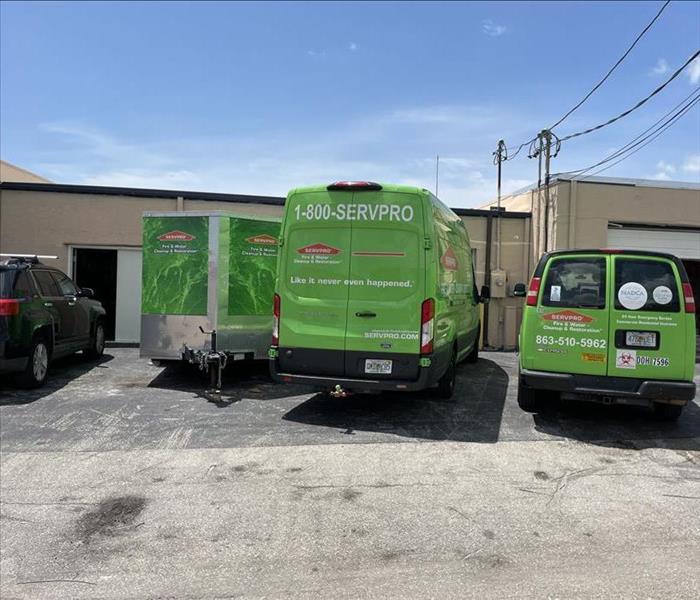 In this blog, we will explore the benefits of professional upholstery cleaning after a fire, highlighting the importance of material cleaning.
In this blog, we will explore the benefits of professional upholstery cleaning after a fire, highlighting the importance of material cleaning.
After a fire incident, the damage caused by smoke and soot extends beyond the structure itself. Upholstered furniture and fabrics can suffer significant smoke and fire damage, resulting in unpleasant odors, stains, and soot particles deeply embedded within the materials. Professional upholstery cleaning services are crucial in restoring fire-damaged upholstery and ensuring its longevity. In this blog, we will explore the benefits of professional upholstery cleaning after a fire, highlighting the importance of material cleaning and contents restoration in comprehensive fire damage restoration and remediation efforts.
Efficient Smoke and Soot Removal
Professional upholstery cleaning after a fire ensures thorough smoke and soot removal from your furniture. Trained technicians use specialized equipment, such as high-powered vacuums and industrial-grade cleaning agents, to effectively extract and eliminate smoke particles, soot, and residue from the fabric. This meticulous cleaning process minimizes the risk of lingering odors and prevents further damage caused by corrosive soot particles.
Restoration of Upholstery Appearance
Fire and smoke damage can leave upholstery looking dull, discolored, and stained. Professional upholstery cleaning techniques, such as hot water extraction or dry cleaning, help restore the appearance of the fabric by removing soot, stains, and discoloration. With the right cleaning methods and products, technicians can revive the color, texture, and overall aesthetics of the upholstery, making it look fresh and clean once again.
Elimination of Lingering Odors
One of the most significant benefits of professional upholstery cleaning after a fire is the elimination of lingering smoke odors from the fabric. Smoke particles tend to embed themselves deep within the upholstered material, leading to persistent and unpleasant smells. Professional cleaning methods, such as steam cleaning and deodorization, effectively remove these odor-causing particles, leaving the upholstery smelling fresh and free from any reminders of the fire incident.
Prevention of Further Damage
When left unaddressed, smoke residues and soot particles can further damage upholstery over time. The corrosive nature of these particles can cause discoloration, staining, and even deterioration of the fabric fibers. By professionally cleaning the upholstery promptly after a fire, you prevent the risk of progressive damage, extending the lifespan of the furniture and protecting your investment.
Restoration of Contents
Professional upholstery cleaning is an essential component of comprehensive contents restoration after fires. Furniture and upholstery are valuable assets, and restoring them can significantly reduce replacement costs. By investing in professional cleaning services, you can salvage fire-damaged upholstery, bringing it back to its pre-fire condition and preserving cherished items with sentimental value.
Expertise and Access to Specialized Equipment
Professional upholstery cleaning services bring expertise and industry knowledge to the restoration process. Trained technicians have the experience to handle various upholstery materials, identifying the most effective cleaning methods and products for optimal results. Additionally, they have access to specialized cleaning equipment and tools that are not readily available to homeowners. Their expertise paired with advanced equipment ensures thorough and efficient cleaning, enhancing the overall success of fire damage restoration efforts.
Professional upholstery cleaning plays a crucial role in fire damage restoration and remediation. By efficiently removing smoke and soot particles, restoring the appearance of upholstery, eliminating lingering odors, and preventing further damage, professional cleaning services offer invaluable benefits. When faced with fire-damaged upholstery, it is essential to engage the services of professional fire damage restoration experts, such as SERVPRO®, who possess the knowledge, expertise, and specialized equipment needed for effective material cleaning and contents restoration. Let the professionals handle the restoration process, and you can have confidence in the successful recovery of your upholstered furniture after a fire.
Mold Removal vs. Mold Remediation: What's the Difference?
3/13/2024 (Permalink)
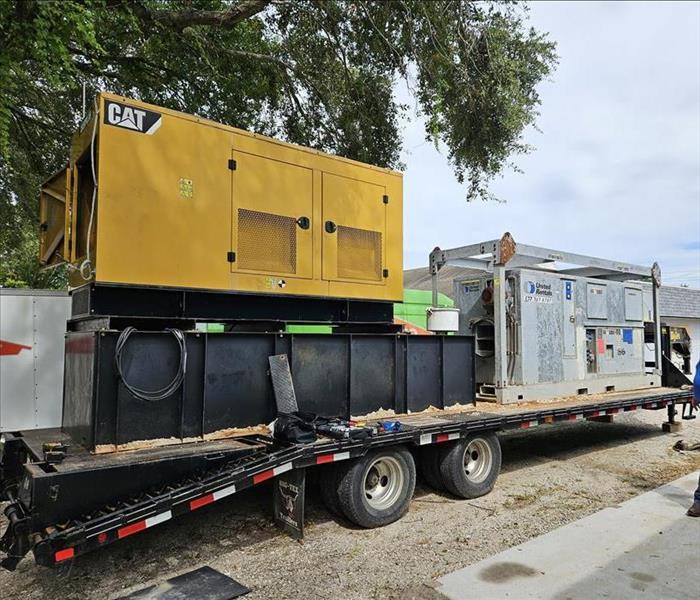 When it comes to dealing with mold in your home, it's important to understand the difference between mold removal and mold remediation.
When it comes to dealing with mold in your home, it's important to understand the difference between mold removal and mold remediation.
When it comes to dealing with mold in your home, it's important to understand the difference between mold removal and mold remediation. While these terms are often used interchangeably, they refer to distinct processes. In this blog, we will explore the differences between mold removal and mold remediation, shedding light on the appropriate approach to address mold issues effectively.
Mold Removal: A Temporary Solution
Mold removal, also known as mold cleanup or mold abatement, refers to the process of physically removing visible mold growth from surfaces. This process typically includes wiping, scrubbing, or vacuuming affected areas to eliminate visible mold.
While mold removal can effectively get rid of existing mold growth, it does not address the underlying cause of the mold issue. Without eliminating the moisture problem or source of humidity, mold is likely to reappear in the future. Therefore, mold removal alone is considered a temporary solution and does not provide long-term protection against mold recurrence.
Mold Remediation: A Comprehensive Approach
On the other hand, mold remediation takes a more comprehensive approach. Mold remediation focuses not only on removing mold growth but also on addressing the underlying causes and preventing future mold problems.
Mold remediation involves the following steps:
- Assessment: Trained professionals inspect the affected area to identify the extent of mold growth, sources of moisture, and potential hidden mold.
- Containment: To prevent the spread of mold spores, technicians isolate the affected area using physical barriers and negative air pressure systems.
- Filtration: High-efficiency particulate air (HEPA) filters are used to capture and remove mold spores and other particles from the air during the remediation process.
- Mold Removal: Mold-affected materials that cannot be salvaged are safely removed and disposed of. The remaining surfaces are thoroughly cleaned and treated with antimicrobial agents to inhibit mold growth.
- Moisture Control: Professionals address the moisture problem by repairing leaks, improving ventilation, or implementing appropriate drying techniques to ensure long-term prevention of mold growth.
- Restoration: Finally, mold restoration services restore the affected area to its pre-damage condition. This may involve repairing or replacing damaged materials, such as drywall or flooring.
The Benefits of Mold Remediation
Compared to mold removal alone, mold remediation provides several key benefits:
- Long-Term Solution: By addressing the underlying moisture issue, mold remediation helps prevent future mold growth, providing a more long-term solution.
- Comprehensive Approach: Mold remediation not only removes visible mold but also ensures thorough cleaning and treatment of affected surfaces, reducing the risk of mold recurrence.
- Professional Expertise: Trained professionals, such as those at SERVPRO, have the knowledge, experience, and specialized equipment necessary to effectively handle mold remediation.
- Property Restoration: Mold restoration services included in the remediation process help restore your property to its pre-damage condition, saving you time, money, and stress.
Mold Restoration Services
Understanding the difference between mold removal and mold remediation is crucial for effectively addressing mold issues in your home. While mold removal alone provides a temporary solution by eliminating visible mold growth, mold remediation takes a comprehensive approach by addressing the underlying causes, preventing future mold problems, and restoring your property.
When it comes to mold issues, it's best to consult professionals like SERVPRO® who offer mold remediation and restoration services. Their expertise and specialized equipment ensure that mold problems are handled thoroughly and effectively, providing you with peace of mind and a safe, mold-free living environment.
How To Prevent HVAC Water Damage
2/14/2024 (Permalink)
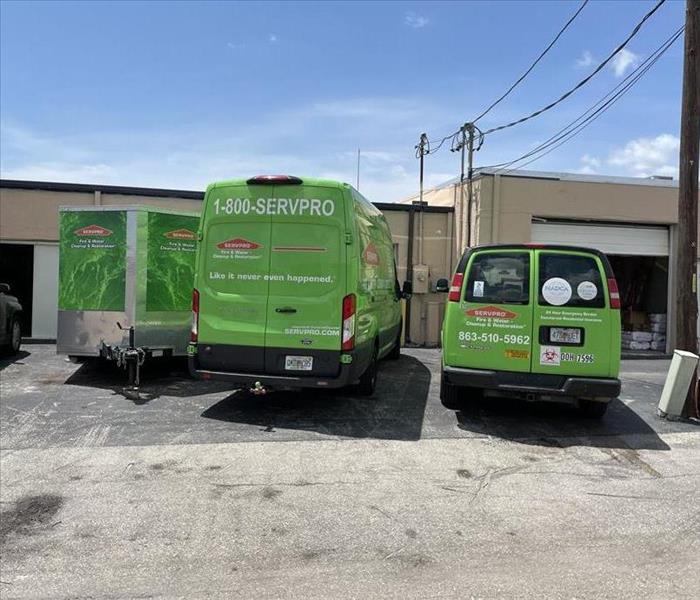 By partnering with professionals like SERVPRO, property owners can mitigate the risks associated with HVAC-related water damage.
By partnering with professionals like SERVPRO, property owners can mitigate the risks associated with HVAC-related water damage.
Heating, Ventilation, and Air Conditioning systems are integral to maintaining comfort in our homes or businesses. However, they can also be sources of potential water damage if not properly maintained. At SERVPRO®, we understand the importance of preventing HVAC-related water damage. In this article, we'll explore key strategies to protect your property from such incidents.
Regular Maintenance and Inspections
Consistent maintenance is crucial in preventing HVAC-related water damage. Schedule routine inspections by qualified professionals to check for leaks, condensation buildup, and clogged drains. Timely identification and repair of potential issues can prevent larger problems.
Change Filters Regularly
Dirty filters can cause HVAC systems to work inefficiently, leading to condensation buildup and potential water leaks. Change air filters regularly as recommended by manufacturers to maintain proper airflow and reduce the risk of water-related issues.
Keep Drain Lines Clear
Drain lines can become clogged over time, leading to water backup and potential overflows. Ensure drain lines are clear from debris or algae buildup by flushing them regularly. Consider adding algaecide tablets to prevent microbial growth.
Monitor Condensate Pans
Check condensate pans for standing water or debris accumulation. Overflowing or damaged pans can cause water to leak into surrounding areas. Regularly clean and maintain these pans to prevent potential leaks.
Inspect Insulation and Seals
Proper insulation around HVAC components and seals in ductwork is essential in preventing condensation and subsequent water damage. Inspect insulation for signs of wear or damage, and ensure seals are intact to prevent moisture intrusion.
Ensure Proper Slope and Drainage
Properly installed HVAC units should have adequate slope and drainage mechanisms to prevent water buildup. Ensure that units are installed correctly and that drainage is directed away from the property.
Install Leak Detection Devices
Consider installing water leak detection devices near HVAC systems. These devices can provide early alerts in case of leaks, allowing for timely intervention to prevent extensive damage.
Educate and Train Personnel
If you manage commercial properties, ensure that maintenance staff or personnel responsible for HVAC systems are trained to identify potential issues and understand preventive measures.
Why SERVPRO® for HVAC-Related Water Damage?
- Swift Response: Our 24/7 emergency service ensures immediate response to mitigate HVAC-related water damage, minimizing disruptions.
- Expertise: With specialized expertise in water damage restoration, our professionals deliver efficient solutions using advanced equipment.
- Preventive Strategies: We offer guidance on preventive measures to minimize the risk of HVAC-related water damage for both residential and commercial properties.
HVAC systems play a vital role in maintaining comfortable environments, but without proper maintenance, they can lead to water damage issues. By implementing these preventive strategies and partnering with professionals like SERVPRO of NE Hillsborough/Plant City, property owners can mitigate the risks associated with HVAC-related water damage.
Tips to Protect Against Storm Damage
1/8/2024 (Permalink)
Electronics are integral parts of our daily lives, yet they are vulnerable to damage during storms. Lightning strikes, power surges, and water exposure pose significant risks to our valuable devices. We've compiled a list of tips to protect your electronics during storms.
Invest in Surge Protectors
Surge protectors act as the first line of defense against electrical surges caused by lightning strikes or power fluctuations. Use high-quality surge protectors for your electronic devices, including computers, TVs, gaming consoles, and other valuable equipment. Consider whole-house surge protection systems for added security.
Unplug During Storms
Before a storm hits, unplug electronic devices from power outlets. This simple step can prevent damage caused by power surges or lightning strikes. Keeping devices disconnected from power sources eliminates the risk of electrical surges damaging sensitive circuitry.
Utilize Battery Backup Systems
Invest in uninterruptible power supply units or battery backup systems for critical electronics like computers and home entertainment systems. These devices provide temporary power during outages, giving you time to properly shut down equipment and prevent data loss or hardware damage.
Create a Safe Storage Space
Designate a safe area within your home to store electronics during storms. Keep them away from windows and doors to minimize exposure to potential water damage. Additionally, consider elevated storage to protect against flooding.
Implement Insurance Coverage
Review your insurance policy to ensure adequate coverage for electronics damaged during storms. Understanding your policy's coverage for electronic devices can provide peace of mind and financial protection in case of unforeseen damage.
Backup Data Regularly
Backing up your electronic data is crucial. Use cloud storage solutions or external hard drives to regularly back up important files, documents, and media. In the event of damage or loss, having backups ensures that your valuable data remains accessible.
Post-Storm Inspection
After a storm passes, conduct a thorough inspection of your electronics. Look for signs of water damage, unusual behavior, or visible damage. If any issues are detected, refrain from powering on the devices and seek professional assistance for evaluation and restoration.
Protecting your electronics during storms requires proactive measures and thoughtful preparation. By implementing these tips, you can significantly reduce the risk of damage to your valuable devices. Remember, SERVPRO of NE Hillsborough/Plant City is here to assist you in the event of storm-related damage.
The Importance of Air Duct Cleaning After a Fire
12/16/2023 (Permalink)
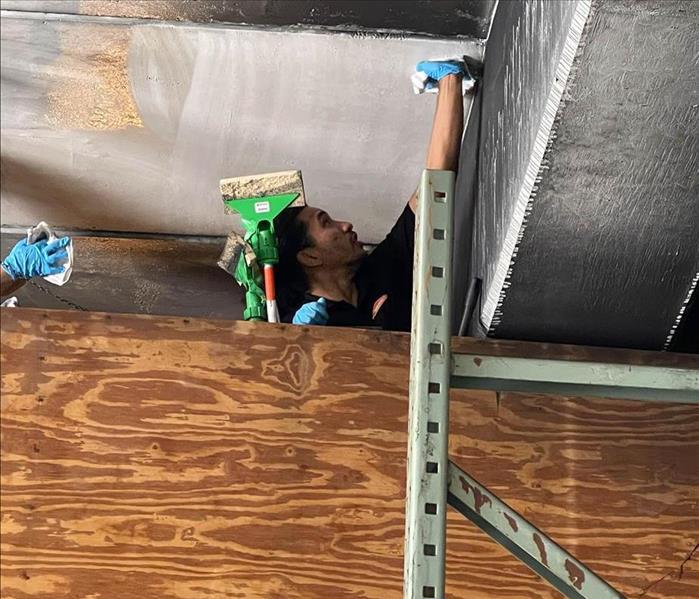 Fires produce a cocktail of harmful elements, including smoke and soot.
Fires produce a cocktail of harmful elements, including smoke and soot.
Experiencing a fire accident is a traumatic event that can leave your home or business with more than just visible damage. While the immediate focus is on addressing fire damage, one aspect that's often overlooked is the impact on your indoor air quality. In this blog, we will delve into why it's crucial to clean your air ducts after a fire accident and how this step can significantly contribute to your property's restoration and the well-being of its occupants.
1. Smoke and Soot Residue
Fires produce a cocktail of harmful elements, including smoke and soot. These particulates can infiltrate your HVAC system, settling in the air ducts and compromising indoor air quality. Neglecting to clean the air ducts can result in ongoing exposure to these harmful substances, potentially leading to health issues.
2. Odor Removal
One of the most noticeable and persistent effects of a fire accident is the lingering odor of smoke. This odor can be challenging to eliminate, especially when it has permeated your air ducts. Cleaning your air ducts is a critical step in removing these odors, making your indoor environment more pleasant and comfortable.
3. Health and Safety
The smoke and soot particles released during a fire contain various harmful substances, including carbon monoxide, volatile organic compounds (VOCs), and other toxic materials. If these contaminants are left in your air ducts, they can continue to circulate in your indoor air, posing risks to occupants. Regular air duct cleaning is essential for maintaining a healthy indoor environment.
4. Preventing Resettlement of Contaminants
Smoke and soot particles are highly adhesive, which means they can easily settle on surfaces, including those within your air ducts. If left unaddressed, these contaminants can become a reservoir for further contamination. Cleaning your air ducts not only removes existing pollutants but also prevents their resettlement.
5. Efficiency and Longevity of HVAC System
A clean HVAC system operates more efficiently and has a longer lifespan. When smoke and soot particles accumulate in the system, it forces it to work harder to maintain temperature and air quality. This can result in increased energy consumption and potential breakdowns. Air duct cleaning helps improve the efficiency and longevity of your HVAC system.
6. Comprehensive Restoration
Cleaning your air ducts is a crucial component of comprehensive fire damage restoration. By addressing all aspects of fire damage, including air duct cleaning, you ensure that your property is fully restored to its pre-fire condition.
In conclusion, cleaning your air ducts after a fire accident is not just an aesthetic choice; it's a critical step in ensuring the safety, health, and comfort of your indoor environment. The lingering effects of smoke and soot, from odors to contaminants, can persist if not addressed. Professional air duct cleaning services, like those offered by SERVPRO® of NE Hillsborough/Plant City, are essential for a complete and thorough fire damage restoration process. Prioritizing air duct cleaning contributes to a healthier and safer indoor environment for you and your loved ones.
A Guide on How to Prevent and Eliminate Kitchen Mold
11/14/2023 (Permalink)
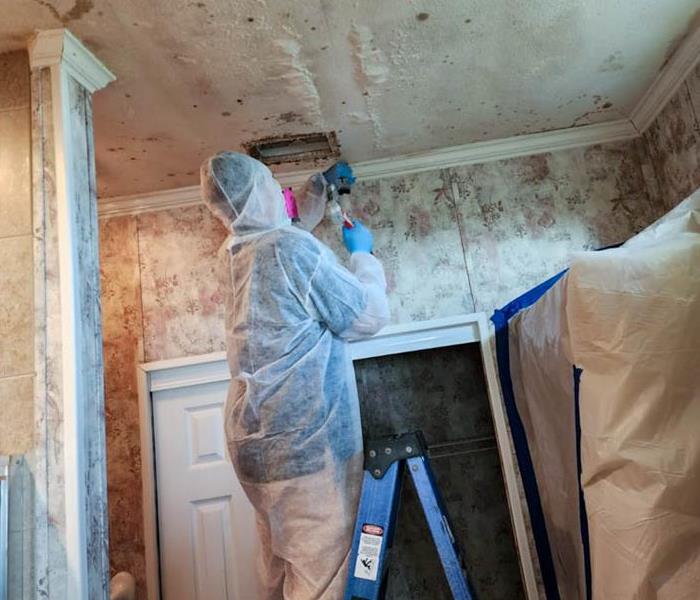 For extensive mold problems, it's best to hire a professional mold remediation service.
For extensive mold problems, it's best to hire a professional mold remediation service.
Living in Florida comes with its fair share of moisture and humidity, which can create the ideal conditions for mold growth, especially in your kitchen. In this post, we'll discuss some practical tips to help you prevent and eliminate mold in your kitchen in the Plant City, FL area.
Understanding the Mold Threat in Plant City, FL
Plant City's warm and humid climate makes it a perfect breeding ground for mold. Kitchens, with their high moisture levels and organic materials, are particularly susceptible. Mold not only looks unsightly but can also severely damage your property.
Preventing Kitchen Mold
Ventilation is Key
Proper ventilation is essential for reducing humidity levels in your kitchen. Use exhaust fans, open windows, and run dehumidifiers to maintain healthy airflow. Ventilation is your first line of defense against mold growth.
Fix Leaks Promptly
Even minor leaks under sinks, around faucets, or in pipes can provide enough moisture for mold to thrive. Be vigilant about fixing leaks as soon as they're detected to prevent mold from gaining a foothold.
Regular Cleaning
Regularly clean your kitchen, paying attention to all surfaces and hidden areas. Mold can grow on countertops, backsplashes, and inside cabinets. Use mold-resistant cleaners and scrubbing tools to eliminate any existing mold.
Store Food Properly
Keep food items sealed and stored in airtight containers to prevent moisture buildup and mold growth. Inspect your pantry regularly for any signs of mold on food or shelves.
Eliminating Kitchen Mold
Identify the Source
If you discover mold in your kitchen, it's essential to determine the source. Mold often grows in hidden areas, like behind walls or under cabinets. Identifying the source will help you prevent its return.
DIY Cleanup
For minor mold issues, you can tackle the cleanup yourself. Use protective gear, like gloves and masks, and scrub the affected areas with a mixture of water and mold-cleaning solutions. Make sure to dry the area completely afterward.
Professional Remediation
For extensive mold problems or when it's beyond your comfort level, it's best to hire a professional mold remediation service. SERVPRO® of Northeast Hillsborough/Plant City offers expert mold removal services tailored to the local climate and conditions.
Mold in your kitchen can be a persistent issue in Plant City, FL, but with the right prevention and elimination strategies, you can keep your kitchen mold-free. Remember to stay vigilant, address any water issues promptly, and consider professional assistance when needed. By following these guidelines, you'll create a clean and safe kitchen environment for you and your family. If you require expert mold remediation, contact SERVPRO® for fast and effective solutions.
How To Prepare Your Community Against Water-Related Disasters
10/9/2023 (Permalink)
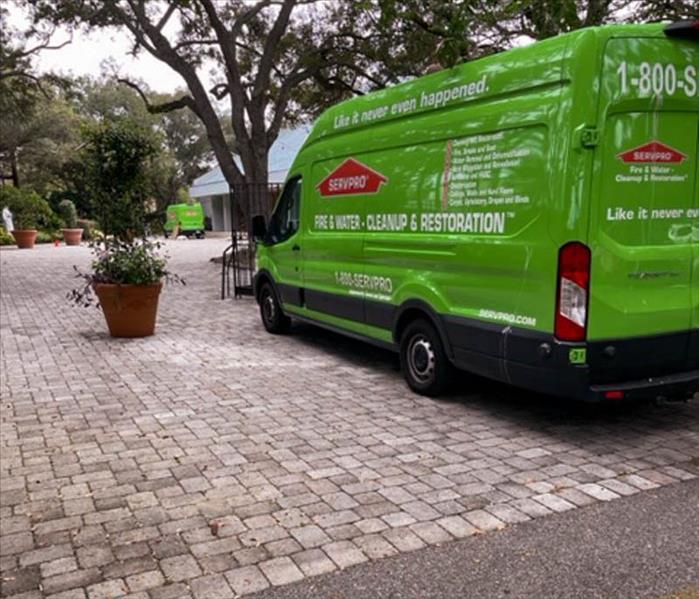 Community resilience against water-related disasters in Florida is not only a responsibility but a necessity.
Community resilience against water-related disasters in Florida is not only a responsibility but a necessity.
Florida, renowned for its picturesque coastlines and natural beauty, faces the recurring threat of water-related disasters. Hurricanes, flooding, and heavy rains often challenge our communities. To address these risks and foster resilience, it's essential for Florida residents to unite and take proactive measures. In this blog, we'll explore strategies and steps for bolstering community resilience against water-related disasters in the Sunshine State.
Community Preparedness Workshops
One of the initial steps in building resilience is educating the community. Organizing workshops that focus on preparedness can empower residents with knowledge about water-related disasters and the measures they can take to safeguard their homes and families. These workshops can cover topics such as hurricane preparedness, flood safety, and disaster response plans.
Emergency Response Planning
Communities should collaborate to formulate comprehensive emergency response plans. These plans must encompass evacuation routes, designated shelters, and effective communication strategies. Ensuring that every member of the community knows their role during a disaster can save lives and reduce panic.
Flood Preparedness and Mitigation
Flooding is a recurring threat in Florida, especially during hurricane season. Communities can invest in flood mitigation efforts such as improved drainage systems, elevation of vulnerable properties, and the creation of green spaces that can absorb excess water. Additionally, residents can take steps to protect their homes, like installing flood barriers and elevating utilities.
Storm-Resistant Building Practices
Florida's building codes have evolved to become some of the most stringent in the country, emphasizing hurricane-resistant construction. Encouraging and enforcing these codes ensures that new construction can withstand water-related disasters. Existing structures can also be retrofitted to improve their resilience.
Community Engagement and Support
Building resilience is a collective effort. Encourage neighbors to check in on each other, particularly vulnerable populations like the elderly and those with disabilities. Create community networks that can provide support during and after disasters. Knowing that you have a strong support system can alleviate stress during challenging times.
Professional Disaster Restoration Services
In the aftermath of a water-related disaster, it's essential to have access to professional disaster restoration services. Companies like SERVPRO® are well-equipped to handle water damage restoration, mold remediation, and more. Having a reliable restoration partner can expedite recovery efforts.
Community resilience against water-related disasters in Florida is not only a responsibility but a necessity. By educating ourselves, planning ahead, and working together, we can better protect our homes and loved ones. Remember, disasters can happen at any time, so it's essential to be prepared. If your community is affected by a water-related disaster, count on SERVPRO® to help you get back on your feet. We're here to support our fellow Floridians when they need it most.
What is the Saffir-Simpson Hurricane Wind Scale?
9/17/2023 (Permalink)
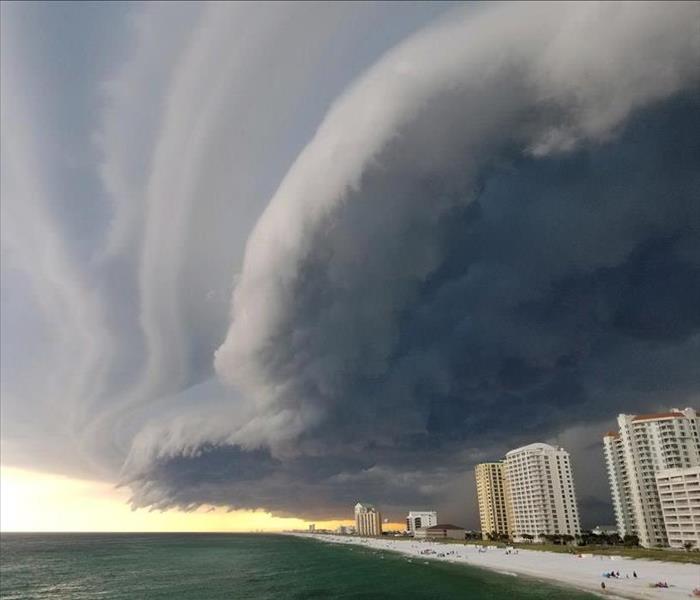 By taking these steps, you can better protect your home, loved ones, and property during the unpredictable hurricane season.
By taking these steps, you can better protect your home, loved ones, and property during the unpredictable hurricane season.
Hurricanes are powerful natural disasters that can cause extensive damage to homes and properties. To better understand and prepare for these storms, it is crucial to familiarize yourself with the Saffir-Simpson Hurricane Wind Scale. Developed in 1971, this scale categorizes hurricanes based on their wind speeds and provides valuable insights into their potential impact. In this blog, we will explore the Saffir-Simpson Hurricane Wind Scale, empowering homeowners and property owners with the knowledge to safeguard their assets and stay safe during hurricane season.
What is the Saffir-Simpson Hurricane Wind Scale?
The Saffir-Simpson Hurricane Wind Scale, commonly referred to as the Hurricane Scale, is a classification system used to categorize hurricanes based on their sustained wind speeds. The scale, ranging from Category 1 to Category 5, helps meteorologists and emergency responders assess the potential damage and impact of an approaching hurricane.
Understanding Each Category
Category 1 (74-95 mph): Hurricanes in this category are considered weak, with wind speeds that can cause minimal damage to homes, trees, and power lines. While still dangerous, preparations for a Category 1 hurricane should focus on securing loose items and preparing for possible power outages.
Category 2 (96-110 mph): Category 2 hurricanes bring stronger winds that can cause moderate damage to roofs, windows, and mobile homes. It is crucial to reinforce weak structures and secure outdoor belongings before the storm arrives.
Category 3 (111-129 mph): A Category 3 hurricane is considered a major hurricane. It can cause extensive damage to well-built homes, uproot trees, and disrupt power and water services. Evacuation may be necessary in areas prone to storm surges.
Category 4 (130-156 mph): Category 4 hurricanes are extremely dangerous and can cause severe structural damage to homes and buildings. Widespread power outages, flooding, and storm surges are expected. Evacuation orders are often issued for vulnerable coastal communities.
Category 5 (157 mph or higher): The most catastrophic hurricanes fall under Category 5. These storms cause complete roof failure, extensive damage to buildings, and significant infrastructure destruction. Residents in the path of a Category 5 hurricane must evacuate to secure locations.
Importance of Knowing the Scale
Understanding the Saffir-Simpson Hurricane Wind Scale is essential for preparedness and decision-making during hurricane season. It allows homeowners and property owners to gauge the severity of an approaching storm and take appropriate measures to protect their assets and ensure their safety.
Preparedness Measures for Each Category
Based on the category of an approaching hurricane, different levels of preparedness are required. Homeowners should stock up on emergency supplies, create a family evacuation plan, and reinforce their properties based on the anticipated wind strength.
The Saffir-Simpson Hurricane Wind Scale is a valuable tool for homeowners and property owners to comprehend the potential impact of an approaching hurricane. By understanding the differences between each category, individuals can make informed decisions, prepare their homes, and prioritize safety measures accordingly. Familiarize yourself with the scale, stay informed through weather updates, and be proactive in your hurricane preparedness efforts. By taking these steps, you can better protect your home, loved ones, and property during the unpredictable hurricane season.
The Commercial Fire Cleanup Process: Restoring Your Business after a Devastating Fire
8/30/2023 (Permalink)
 Remember, hiring a professional fire restoration company is essential for a successful commercial fire cleanup.
Remember, hiring a professional fire restoration company is essential for a successful commercial fire cleanup.
A fire can be devastating for any business, causing significant damage and disruption. After the flames have been extinguished, it's essential to start the commercial fire cleanup process as soon as possible. This process involves several critical steps to assess the damage, clean up the debris, and restore your business to its pre-fire condition. In this blog post, we will discuss the essential steps involved in commercial fire cleanup and why it's important to hire professionals for this task.
Step 1: Assessment and Safety Measures
The first step in commercial fire cleanup is to assess the extent of the damage. A professional fire restoration company will conduct a thorough inspection to determine the areas affected by the fire, smoke, and soot. They will also evaluate the structural integrity of the building and identify any safety hazards.
During this assessment, safety measures are implemented to protect workers and prevent further damage. These measures may include securing the building, boarding up windows and doors, and setting up temporary fencing.
Step 2: Debris Removal
Once the assessment is complete, the next step is to remove debris. This involves removing damaged materials, such as walls, ceiling tiles, furniture, and equipment. Debris removal is a crucial step as it allows for easier access to the affected areas and prevents further contamination.
Professional fire cleanup teams are skilled in handling debris removal safely and efficiently. They use specialized equipment like dumpsters and heavy-duty machinery to haul away the debris. Proper disposal is also essential to comply with regulations and minimize environmental impact.
Step 3: Smoke and Soot Cleaning
Smoke and soot can cause extensive damage and leave behind lingering odors. The third step in the commercial fire cleanup process involves cleaning and removing smoke and soot residues from surfaces, including walls, ceilings, floors, and equipment.
Experienced professionals use specialized techniques and equipment to effectively clean and restore affected areas. This may involve using chemical cleaners, high-powered vacuums, and thermal fogging to neutralize odors and remove smoke and soot particles.
Step 4: Water and Fire Damage Restoration
Firefighting efforts often result in water damage. The cleanup process includes water extraction and drying to prevent secondary damage, such as mold growth. Fire-damaged areas are then repaired and restored, including structural repairs, electrical and plumbing work, and repainting.
Throughout the commercial fire cleanup process, it is essential to document all the damaged areas, items, and the restoration process itself. This documentation is vital for insurance claims and can help ensure that you receive fair compensation for the damages. Professional restoration companies often work closely with insurance providers to streamline the claims process. They can provide the necessary documentation and assist with filing the insurance claim accurately.
A commercial fire can be a devastating event for any business. However, with the right professionals and a systematic fire cleanup process in place, a business can recover and rebuild. By following the necessary steps, from assessment to documentation, you can restore your business to its former glory.
Remember, hiring a professional fire restoration company is essential for a successful commercial fire cleanup. They have the expertise, equipment, and knowledge to handle the restoration process safely and efficiently, allowing you to focus on getting your business back on track.
Dealing with Accidental Fire Sprinkler Activation: Quick Steps for Effective Response
7/17/2023 (Permalink)
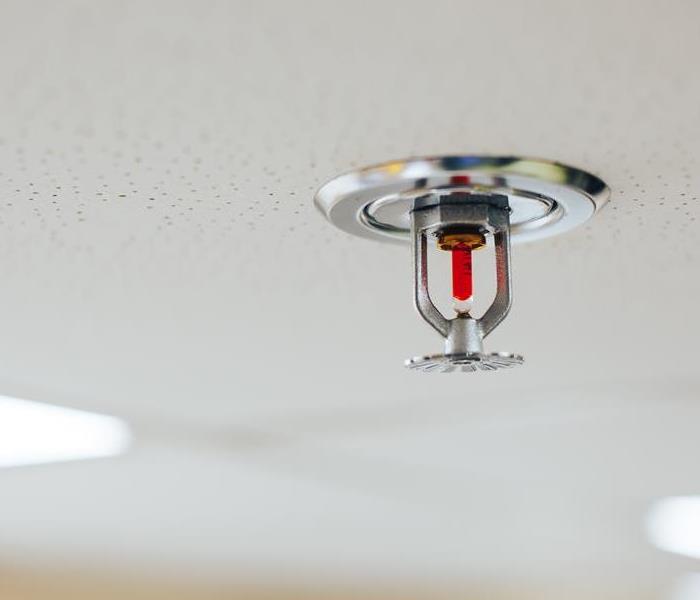 Having fire protection is always top priority in your business.
Having fire protection is always top priority in your business.
Fire sprinkler systems are crucial for protecting lives and property in the event of a fire. However, there may be instances when sprinklers are accidentally triggered, causing water damage and potential disruption. If you find yourself in a situation where fire sprinklers go off accidentally, it's important to take immediate action to mitigate the damage and ensure safety. In this blog post, we will outline the necessary steps to follow if the fire sprinklers are activated unintentionally, helping you navigate through the situation effectively.
Stay Calm and Assess the Situation
The first and most crucial step is to stay calm and assess the situation. Take a moment to understand the extent of the accidental activation and evaluate any potential hazards or risks. Assess whether the sprinklers have been triggered in a single area or throughout the building.
Locate the Water Shutoff Valve
Locate the main water shutoff valve for the fire sprinkler system. It is typically found near the sprinkler riser or in a designated control room. Shutting off the water supply will help minimize further water discharge and damage. Turn the valve clockwise to close it fully.
Contact the Fire Department and Building Management
Notify the fire department and building management immediately about the accidental activation of the fire sprinklers. Provide them with accurate information about the situation and follow any instructions they provide.
Document the Incident
Take photos or videos of the affected areas to document the extent of the damage caused by the accidental sprinkler activation. This documentation may be necessary for insurance claims or discussions with building management.
Remove Excess Water
If possible, use buckets, mops, or towels to start removing excess water from the affected areas. Promptly dry any sensitive or valuable items to prevent further damage. Open windows or use fans to facilitate air circulation and aid in the drying process.
Seek Professional Assistance
Contact a reputable water damage restoration company with experience in handling water emergencies. They can assess the situation, provide professional advice, and assist in the cleanup and restoration process. Their expertise will help ensure proper water extraction, drying, and mitigating any potential mold growth.
Communicate with Insurance Provider
Notify your insurance provider about the accidental activation of the fire sprinklers. Provide them with all relevant information, including photos and documentation of the incident. Consult with them on the necessary steps to file a claim and seek coverage for the damages incurred.
While accidental activation of fire sprinklers can be disruptive and cause water damage, it is crucial to stay calm and take immediate action. By promptly locating and shutting off the water supply, contacting the necessary authorities, documenting the incident, removing excess water, seeking professional assistance, and communicating with your insurance provider, you can effectively manage the situation and minimize the impact of the accidental sprinkler activation. Remember, safety should always be the top priority, and professional assistance is invaluable in restoring your property to its pre-incident condition.



 24/7 Emergency Service
24/7 Emergency Service






